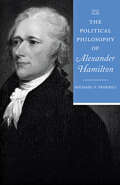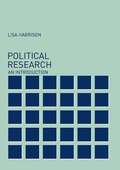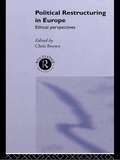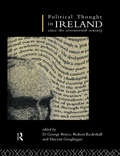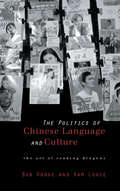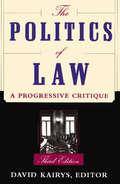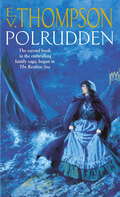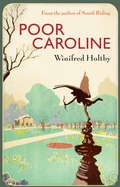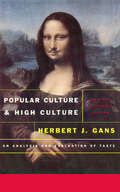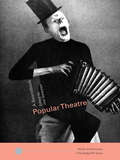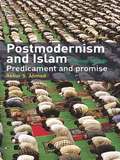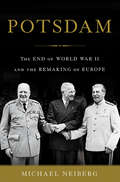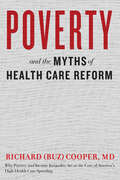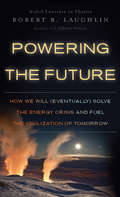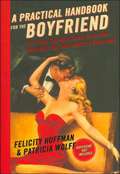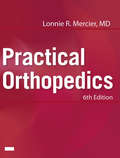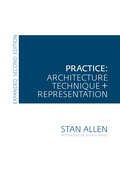- Table View
- List View
The Political Philosophy of Alexander Hamilton (The Political Philosophy of the American Founders)
by Michael P. FedericiAmerica’s first treasury secretary and one of the three authors of the Federalist Papers, Alexander Hamilton stands as one of the nation’s important early statesmen. Michael P. Federici places this Founding Father among the country’s original political philosophers as well.Hamilton remains something of an enigma. Conservatives and liberals both claim him, and in his writings one can find material to support the positions of either camp. Taking a balanced and objective approach, Federici sorts through the written and historical record to reveal Hamilton’s philosophy as the synthetic product of a well-read and pragmatic figure whose intellectual genealogy drew on Classical thinkers such as Cicero and Plutarch, Christian theologians, and Enlightenment philosophers, including Hume and Montesquieu. In evaluating the thought of this republican and would-be empire builder, Federici explains that the apparent contradictions found in the Federalist Papers and other examples of Hamilton’s writings reflect both his practical engagement with debates over the French Revolution, capital expansion, commercialism, and other large issues of his time, and his search for a balance between central authority and federalism in the embryonic American government. This book challenges the view of Hamilton as a monarchist and shows him instead to be a strong advocate of American constitutionalism.Devoted to the whole of Hamilton’s political writing, this accessible and teachable analysis makes clear the enormous influence Hamilton had on the development of American political and economic institutions and policies.
The Political Philosophy of Alexander Hamilton (The Political Philosophy of the American Founders)
by Michael P. FedericiAmerica’s first treasury secretary and one of the three authors of the Federalist Papers, Alexander Hamilton stands as one of the nation’s important early statesmen. Michael P. Federici places this Founding Father among the country’s original political philosophers as well.Hamilton remains something of an enigma. Conservatives and liberals both claim him, and in his writings one can find material to support the positions of either camp. Taking a balanced and objective approach, Federici sorts through the written and historical record to reveal Hamilton’s philosophy as the synthetic product of a well-read and pragmatic figure whose intellectual genealogy drew on Classical thinkers such as Cicero and Plutarch, Christian theologians, and Enlightenment philosophers, including Hume and Montesquieu. In evaluating the thought of this republican and would-be empire builder, Federici explains that the apparent contradictions found in the Federalist Papers and other examples of Hamilton’s writings reflect both his practical engagement with debates over the French Revolution, capital expansion, commercialism, and other large issues of his time, and his search for a balance between central authority and federalism in the embryonic American government. This book challenges the view of Hamilton as a monarchist and shows him instead to be a strong advocate of American constitutionalism.Devoted to the whole of Hamilton’s political writing, this accessible and teachable analysis makes clear the enormous influence Hamilton had on the development of American political and economic institutions and policies.
Political Research: An Introduction
by Lisa Harrison Nicholas StartinPolitical Research: An Introduction has been designed to provide an excellent starting point for those new to the area of Research Methods. It assumes no prior knowledge of the subject and sets out the key issues involved in doing research in Politics. It guides students through a complex and often daunting subject by exploring the many concepts associated with the field, as well as offering practical advice on research practices and information resources. Features and benefits of this textbook include:* boxed case studies in each chapter to illustrate and clarify key concepts, and highlight the practical use of different research methods* a useful glossary, giving easy access to definitions of key terms* a dedicated web-site containing sample material, extra case studies, important links, and essential resources for both teachers and students.
Political Restructuring in Europe: Ethical Perspectives
by Chris BrownA distinguished selection of contributors provide the theoretical background to the restructuring of Europe that is currently underway. It attempts to situate the ethical debates in a historical, legal and constitutional context, considering important and topical issues such as the rights to seccession and self-determination of minorities in Eastern Europe, and the question of whether national movements are justified in using force to achieve their ends.The authors number legal and constitutional scholars, political philosophers and international relations theorists. There are contributions from Poland and Croatia.
Political Thought in Ireland Since the Seventeenth Century
by D. George Boyce Robert Eccleshall Vincent GeogheganThese pioneering essays provide a unique study of the development of political ideas in Ireland from the seventeenth to the twentieth century. The book breaks away from the traditional emphasis in Irish historiography on the nationalism/unionism debate to focus instead on previously neglected areas such as the role of the Scottish Enlightenment and early Irish socialism and conservatism. A wide range of original primary sources are used from pamphlets to journalism, devotional tracts to poetry.
The Politics of American Economic Policy Making
by Paul PeretzA reader on American government and the economy. It contains wide-ranging articles by people such as Richard Musgrave, Milton Friedman, James Buchanan, and Alan Greenspan.
Politics of Chinese Language and Culture: The Art of Reading Dragons
by Bob Hodge Kam LouieAn innovative text which adopts the tools of cultural studies to provide a fresh approach to the study of Chinese language, culture and society. The book tackles areas such as grammar, language, gender, popular culture, film and the Chinese diaspora and employs the concepts of social semiotics to extend the ideas of language and reading. Covering a range of cultural texts, it will help to break down the boundaries around the ideas and identities of East and West and provide a more relevant analysis of the Chinese and China.
The Politics Of Law: A Progressive Critique, Third Edition
by David KairysThe Politics of Law is the most widely read critique of the nature and role of the law in American society. This revised edition continues the book's concrete focus on the major subjects and fields of law. New essays on emerging fields and the latest trends and cases have been added to updated versions of the now-classic essays from earlier editions.A unique assortment of leading scholars and practitioners in law and related disciplines-political science, economics, sociology, criminology, history, and literature-raise basic questions about law, challenging long-held ideals like the separation of law from politics, economics, religion, and culture. They address such issues contextually and with a keen historical perspective as they explain and critique the law in a broad range of areas.This third edition contains essays on all of the subjects covered in the first year of law school while continuing the book's tradition of accessibility to non-law-trained readers. Insightful and powerful, The Politics of Law makes sense of the debates about judicial restraint and the range of legal controversies so central to American public life and culture.
Polrudden: Number 2 in series (Jagos of Cornwall #2)
by E. V. ThompsonOn a wild stormy night in 1813, Nathan Jago, drift fisherman, ex-prizefighter and lord of the manor of Polrudden, rescues a young boy from a drowning mother's arms as a French ship founders on the jagged Cornish rocks. It is an act that will profoundly affect his destiny. Despite hard times, Nathan and his wife Amy adopt Jean-Paul and bring him up with their own son. Nathan considers a return to the ring in the struggle to make a living and keep the ancient house in the family. But events conspire to involve him in a royalist intrigue that eventually leads to Paris - where a beautiful marquise and a dashing count sow the seeds both of tragedy and renewed hope...
Poor Caroline (Virago Modern Classics #694)
by Winifred HoltbyCaroline Denton-Smyth is an eccentric, dressed in trailing feathers and jangling beads, peering out from behind her lorgnette. Sitting alone in her West Kensington bedsitter, she dreams of the Christian Cinema Company - her vehicle for reform. For Caroline sees herself as a pioneer, one who must risk everything for the 'Cause of the Right'. Her Board of Directors is a motley crew including Basil St Denis, upper crust but impecunious; Joseph Isenbaum, aspiring to Society and Eton for his son; Eleanor de la Roux, Caroline's independent cousin from South Africa; Hugh Macafee, a curt Scottish film technician; young Father Mortimer, scarred from the First World War; and Clifton Johnson, a seedy American scenario writer on the make. Winifred Holtby affectionately observes the foibles of human nature in this sparkiling satire, first published in 1931.
Popular Culture and High Culture: An Analysis and Evaluation Of Taste
by Herbert GansIs NYPD Blue a less valid form of artistic expression than a Shakespearean drama? Who is to judge and by what standards?In this new edition of Herbert Gans's brilliantly conceived and clearly argued landmark work, he builds on his critique of the universality of high cultural standards. While conceding that popular and high culture have converged to some extent over the twenty-five years since he wrote the book, Gans holds that the choices of typical Ivy League graduates, not to mention Ph.D.'s in literature, are still very different from those of high school graduates, as are the movie houses, television channels, museums, and other cultural institutions they frequent.This new edition benefits greatly from Gans's discussion of the ”politicization” of culture over the last quarter-century. Popular Culture and High Culture is a must read for anyone interested in the vicissitudes of taste in American society.
Popular European Cinema
by Richard Dyer Ginette VincendeauPopular European Cinema examines the reasons why films that are most popular with audiences in any one European countha are seldom successful eslewhere. Audiences themselves represent diverse class, gender and ethnic identities that complicate th equestoin of national cinema, not least with recent developments in formerly communist Eastern Europe and post-colonialist Western Europe. THrough their individual studies, the contribuitots ehr oven up a new area of study, using the medium of film to fucus a wider discussion of popular European culture.
Popular Theatre: A Sourcebook (Worlds of Performance)
by Joel SchechterBertolt Brecht turned to cabaret; Ariane Mnouchkine went to the circus; Joan Littlewood wanted to open a palace of fun. These were a few of the directors who turned to popular theatre forms in the last century, and this sourcebook accounts for their attraction.Popular theatre forms introduced in this sourcebook include cabaret, circus, puppetry, vaudeville, Indian jatra, political satire, and physical comedy. These entertainments are highly visual, itinerant, and readily understood by audiences. Popular Theatre: A Sourcebook follows them around the world, from the bunraku puppetry of Japan to the masked topeng theatre of Bali to South African political satire, the San Francisco Mime Troupe's comic melodramas, and a 'Fun Palace' proposed for London.The book features essays from the archives of The Drama Review and other research. Contributions by Roland Barthes, Hovey Burgess, Marvin Carlson, John Emigh, Dario Fo, Ron Jenkins, Joan Littlewood, Brooks McNamara, Richard Schechner, and others, offer some of the most important, informative, and lively writing available on popular theatre. Introducing both Western and non-Western popular theatre practices, the sourcebook provides access to theatrical forms which have delighted audiences and attracted stage artists around the world.
Postmodernism and Islam: Predicament and Promise
by Akbar S. AhmedCan West and East ever understand each other? In this extraordinary book one of the world's leading Muslim scholars explores an area which has which has been almost entirely neglected by scholars in the field - the area of postmodernism and Islam. This landmark work is startling, constantly perceptive and certain to be debated for years to come.
A Posy of Wild Flowers: A Gypsy Girl at Heart
by Rosemary PenfoldMore gypsy tales from the SUNDAY TIMES bestselling author...Rosemary Penfold's A FIELD FULL OF BUTTERFLIES was a beautiful and evocative memoir of her life growing up in the fields of the English countryside. A moving testament to a forgotten world and a rapidly disappearing and often misunderstood people, Rosemary won the hearts of the nation with her story. In this, her second book, Rosemary returns to the idyllic countryside to continue her compelling story. Written in the same elegant narrative that has made Rosemary a much loved and admired storyteller, she paints a vivid and touching portrait of a way of life that no longer exists. It is a heartwarming tale of a fast-changing world, which captures the hopes and struggles, loves and losses, traditions and prejudices of a Romany community.
Potsdam: The End of World War II and the Remaking of Europe
by Michael NeibergThe definitive account of the 1945 Potsdam Conference: the historic summit where Truman, Stalin, and Churchill met to determine the fate of post-World War II EuropeAfter Germany's defeat in World War II, Europe lay in tatters. Millions of refugees were dispersed across the continent. Food and fuel were scarce. Britain was bankrupt, while Germany had been reduced to rubble. In July of 1945, Harry Truman, Winston Churchill, and Joseph Stalin gathered in a quiet suburb of Berlin to negotiate a lasting peace: a peace that would finally put an end to the conflagration that had started in 1914, a peace under which Europe could be rebuilt.The award-winning historian Michael Neiberg brings the turbulent Potsdam conference to life, vividly capturing the delegates' personalities: Truman, trying to escape from the shadow of Franklin Roosevelt, who had died only months before; Churchill, bombastic and seemingly out of touch; Stalin, cunning and meticulous. For the first week, negotiations progressed relatively smoothly. But when the delegates took a recess for the British elections, Churchill was replaced-both as prime minster and as Britain's representative at the conference-in an unforeseen upset by Clement Attlee, a man Churchill disparagingly described as "a sheep in sheep's clothing." When the conference reconvened, the power dynamic had shifted dramatically, and the delegates struggled to find a new balance. Stalin took advantage of his strong position to demand control of Eastern Europe as recompense for the suffering experienced by the Soviet people and armies. The final resolutions of the Potsdam Conference, notably the division of Germany and the Soviet annexation of Poland, reflected the uneasy geopolitical equilibrium between East and West that would come to dominate the twentieth century.As Neiberg expertly shows, the delegates arrived at Potsdam determined to learn from the mistakes their predecessors made in the Treaty of Versailles. But, riven by tensions and dramatic debates over how to end the most recent war, they only dimly understood that their discussions of peace were giving birth to a new global conflict.
Potsdam: The End of World War II and the Remaking of Europe
by Michael NeibergThe definitive account of the 1945 Potsdam Conference: the historic summit where Truman, Stalin, and Churchill met to determine the fate of post-World War II Europe After Germany's defeat in World War II, Europe lay in tatters. Millions of refugees were dispersed across the continent. Food and fuel were scarce. Britain was bankrupt, while Germany had been reduced to rubble. In July of 1945, Harry Truman, Winston Churchill, and Joseph Stalin gathered in a quiet suburb of Berlin to negotiate a lasting peace: a peace that would finally put an end to the conflagration that had started in 1914, a peace under which Europe could be rebuilt. The award-winning historian Michael Neiberg brings the turbulent Potsdam conference to life, vividly capturing the delegates' personalities: Truman, trying to escape from the shadow of Franklin Roosevelt, who had died only months before; Churchill, bombastic and seemingly out of touch; Stalin, cunning and meticulous. For the first week, negotiations progressed relatively smoothly. But when the delegates took a recess for the British elections, Churchill was replaced-both as prime minster and as Britain's representative at the conference-in an unforeseen upset by Clement Attlee, a man Churchill disparagingly described as "a sheep in sheep's clothing." When the conference reconvened, the power dynamic had shifted dramatically, and the delegates struggled to find a new balance. Stalin took advantage of his strong position to demand control of Eastern Europe as recompense for the suffering experienced by the Soviet people and armies. The final resolutions of the Potsdam Conference, notably the division of Germany and the Soviet annexation of Poland, reflected the uneasy geopolitical equilibrium between East and West that would come to dominate the twentieth century. As Neiberg expertly shows, the delegates arrived at Potsdam determined to learn from the mistakes their predecessors made in the Treaty of Versailles. But, riven by tensions and dramatic debates over how to end the most recent war, they only dimly understood that their discussions of peace were giving birth to a new global conflict.
Poverty and the Myths of Health Care Reform
by Richard Buz CooperIn Poverty and the Myths of Health Care Reform, Dr. Richard (Buz) Cooper argues that US poverty and high health care spending are inextricably entwined. Our nation's health care system bears a financial burden that is greater than in any other developed country in large part because impoverished patients use more health care, driving up costs across the board.Drawing on decades of research, Dr. Cooper illuminates the geographic patterns of poverty, wealth, and health care utilization that exist across neighborhoods, regions, and states;¢;‚¬;€?and among countries. He chronicles the historical threads that have led to such differences, examines the approaches that have been taken to combat poverty throughout US history, and analyzes the impact that structural changes now envisioned for clinical practice are likely to have. His research reveals that ignoring the impact of low income on health care utilization while blaming rising costs on waste, inefficiency, and unnecessary care has led policy makers to reshape clinical practice in ways that impede providers who care for the poor.The first book to address the fundamental nexus that binds poverty and income inequality to soaring health care utilization and spending, Poverty and the Myths of Health Care Reform is a must-read for medical professionals, public health scholars, politicians, and anyone concerned with the heavy burden of inequality on the health of Americans.
Poverty and the Myths of Health Care Reform
by Richard Buz CooperIn Poverty and the Myths of Health Care Reform, Dr. Richard (Buz) Cooper argues that US poverty and high health care spending are inextricably entwined. Our nation's health care system bears a financial burden that is greater than in any other developed country in large part because impoverished patients use more health care, driving up costs across the board.Drawing on decades of research, Dr. Cooper illuminates the geographic patterns of poverty, wealth, and health care utilization that exist across neighborhoods, regions, and states;¢;‚¬;€?and among countries. He chronicles the historical threads that have led to such differences, examines the approaches that have been taken to combat poverty throughout US history, and analyzes the impact that structural changes now envisioned for clinical practice are likely to have. His research reveals that ignoring the impact of low income on health care utilization while blaming rising costs on waste, inefficiency, and unnecessary care has led policy makers to reshape clinical practice in ways that impede providers who care for the poor.The first book to address the fundamental nexus that binds poverty and income inequality to soaring health care utilization and spending, Poverty and the Myths of Health Care Reform is a must-read for medical professionals, public health scholars, politicians, and anyone concerned with the heavy burden of inequality on the health of Americans.
The Power of Selling
by Kim RichmondThe Power of Selling is the perfect textbook to teach students about the proven process of selling. More important, it teaches students how to apply the tenets of selling to how to sell themselves and get the job they want, with the same process professional sales people learn (or brush up) on their own selling skills. What makes someone successful in sales? Are great sales people born or made? Is there one magic selling process, or does the process change based on the business...or the customer? How can the selling process really come alive for students in the classroom? How do students learn how to sell for life, not just for a course? The Power of Selling by Kim Richmond answers these questions and makes the principles of selling come alive. Kim looks at the topic of selling through a different lens, and provides inspiration and ideas. The Power of Selling provides an exciting and interactive experience for both professors and students through the use of 4 unique elements: 1. Content The content is based on the core selling tenets so instructors will find the familiar principles of selling. In addition, the impact of Sales 2.0 is addressed at every stage including how to use interactive tools such as Twitter, LinkedIn, Facebook, blogs, and wikis effectively. 2. Selling U The last section of each chapter is called Selling U. It applies the concepts covered in the chapter to a student's job search. Selling U topics include how to think about yourself as a brand, how to create a powerful cover letter and resume, how to create your personal elevator pitch, how to use networking and informational interviews to get the word out about your brand, how to prepare and dress for an interview, and how to negotiate and accept the right job offer. What makes The Power of Selling different is that Selling U is integrated into every chapter, which makes this text the ultimate guide to selling yourself. 3. Video Resources Videos are used throughout the book. Additional videos that are not included in the text are available for instructor use. Here are videos that are available: * Video Ride-alongs - One of the best ways to learn about sales is by going on ride-alongs. So every chapter starts with an exclusive feature called a Video Ride-along. These short videos feature seven different sales professionals - one that starts each chapter. Each one talks about how he or she applies one of the key concepts covered in the chapter in their job. These videos are designed to be "virtual ride-alongs" so the students can actually feel as though they are getting insights first hand from selling professionals. * The Power of Selling YouTube Channel here (youtube.com/thepowerofselling) - Over 50 videos are included featuring the sales professionals who are highlighted in the Video Ride-alongs. About half of the videos are used in the textbook. The balance are available for instructor use. Several are included in Video Learning Segments (see below). These videos are excellent resources for use in the classroom, exercises, and assignments. * Video Learning Segments In addition to the traditional supplements of Instructor Manual, PowerPoints, and Test Bank, there are also Video Learning Segments. These are PowerPoint slides embedded with videos designed to supplement the course PowerPoints and focus on one concept, like an ethical dilemma, pre-call preparation, or effective presentations, how to use email effectively. Each segment includes slides, videos, discussion questions, or exercises. 4. The Power of Selling LinkedIn Group. here This group was created on LinkedIn.com expressly as a resource for the faculty and students who use this textbook. The group includes sales professionals from across the country and from different industries. This is a great tool for faculty and students alike to network, participate in discussions, ask questions, and connect with "real world" selling professionals.
Powering the Future: How We Will (Eventually) Solve the Energy Crisis and Fuel the Civilization of Tomorrow (Playaway Adult Nonfiction Ser.)
by Robert B. LaughlinIn Powering the Future, Nobel laureate Robert B. Laughlin transports us two centuries into the future, when we&’ve ceased to use carbon from the ground—either because humans have banned carbon burning or because fuel has simply run out. Boldly, Laughlin predicts no earth-shattering transformations will have taken place. Six generations from now, there will still be soccer moms, shopping malls, and business trips. Firesides will still be snug and warm.How will we do it? Not by discovering a magic bullet to slay our energy problems, but through a slew of fascinating technologies, drawing on wind, water, and fire. Powering the Future is an objective yet optimistic tour through alternative fuel sources, set in a world where we&’ve burned every last drop of petroleum and every last shovelful of coal. The Predictable: Fossil fuels will run out. The present flow of crude oil out of the ground equals in one day the average flow of the Mississippi River past New Orleans in thirteen minutes. If you add the energy equivalents of gas and coal, it&’s thirty-six minutes. At the present rate of consumption, we&’ll be out of fossil fuels in two centuries&’ time. We always choose the cheapest gas. From the nineteenth-century consolidation of the oil business to the California energy crisis of 2000-2001, the energy business has shown, time and again, how low prices dominate market share. Market forces—not green technology—will be the driver of energy innovation in the next 200 years. The laws of physics remain fixed. Energy will still be conserved, degrade entropically with use, and have to be disposed of as waste heat into outer space. How much energy a fuel can pack away in a given space is fixed by quantum mechanics—and if we want to keep flying jet planes, we will need carbon-based fuels. The Potential: Animal waste.If dried and burned, the world&’s agricultural manure would supply about one-third as much energy as all the coal we presently consume. Trash. The United States disposes of 88 million tons of carbon in its trash per year. While the incineration of waste trash is not enough to contribute meaningfully to the global demand for energy, it will constrain fuel prices by providing a cheap supply of carbon. Solar energy.The power used to light all the cities around the world is only one-millionth of the total power of sunlight pouring down on earth&’s daytime side. And the amount of hydropump storage required to store the world&’s daily electrical surge is equal to only eight times the volume of Lake Mead. PRAISE FOR ROBERT B. LAUGHLIN &“Perhaps the most brilliant theoretical physicist since Richard Feynman&”—George Chapline, Lawrence Livermore National Laboratory &“Powerful but controversial.&”— Financial Times &“[Laughlin&’s] company … is inspirational.&” —New Scientist
A Practical Handbook for the Boyfriend: For Every Guy Who Wants to Be One/For Every Girl Who Wants to Build One
by Felicity HuffmanMost dating books are written for women -- what a mistake that is. Women know how to date . . . It's men who need the help! At last: a blithe, bold, and bawdy guide to building a better boyfriend At some point, every guy -- player, geek, mama's boy, "regular Joe" -- meets a woman who makes him want to be a boyfriend. A good boyfriend. Problem is, unless he's had some first-rate training (by a previous girlfriend, a sister, a mom), he probably doesn't even know what that means. Felicity Huffman and Patricia Wolff come to the rescue with a rollicking -- and whip-smart -- handbook to navigating the minefield of male-female relationships. Directed at men (though of course it's women who'll buy it, then leave it at their boyfriend's place -- accidentally on purpose), A Practical Handbook for the Boyfriend lays out the many steps involved in becoming a good boyfriend, while still maintaining guy-dignity. It covers issues like: -Who decides when you become a boyfriend (answer: She does.) -How to look like you're listening, even when you're not (If you're busted, just say "You're so pretty, I'm distracted.") -Ten things never to say on the first date (#4: "I just did that to freak you out.") -Finding the middle ground between too cool (think third grade) and too eager (think surprise visits) -Why becoming a good boyfriend is a lot like training for the A team Filled with humor, ribaldry, common sense, and assorted outdoor skills, A Practical Handbook for the Boyfriend is the next dating guide to dominate the bestseller lists.
Practical Orthopedics E-Book
by Lonnie MercierThis text equips you with just the right amount of information to make more confident diagnoses, manage the conditions presented by your patients, and determine when to refer them for more specialized treatment. Thoroughly revised and updated, it guides you through the fundamental concepts, diagnostic procedures, and treatment techniques that can help you improve your patients' level of function and lessen their pain.Patient teaching guides for more than 35 disorders — including lower back pain, carpal tunnel syndrome, and osteoporosis — help you assist patients in their recovery. Comprehensive pharmacology information — including guidelines on usage, contraindications, and interactions — enables you to apply the most effective patient treatment approaches.Nearly 350 illustrations — about 100 new to this edition — easily explain key concepts.
Practical Phonetics and Phonology: A Resource Book for Students
by Beverley S. Collins Inger M. MeesRoutledge English Language Introductions cover core areas of language study and are one-stop resources for students. Assuming no prior knowledge, books in the series offer an accessible overview of the subject, with activities, study questions, sample analyses, commentaries and key readings—all in the same volume. The innovative and flexible ‘two-dimensional’ structure is built around four sections—introduction, development, exploration and extension—which offer self-contained stages for study. Each topic can also be read across these sections, enabling the reader to build gradually on the knowledge gained. Revised and updated throughout, this third edition of Practical Phonetics and Phonology: presents the essentials of the subject and their day-to-day applications in an engaging and accessible manner covers all the core concepts of speech science, such as the phoneme, syllable structure, production of speech, vowel and consonant possibilities, glottal settings, stress, rhythm, intonation and the surprises of connected speech incorporates classic readings from key names in the discipline including David Abercrombie, David Crystal, Dennis Fry, Daniel Jones, Peter Ladefoged, Peter Trudgill and John Wells includes an audio CD containing a collection of samples provided by genuine speakers of 25 accent varieties from Britain, Ireland, the USA, Canada, Australia, New Zealand, South Africa, India, Singapore and West Africa gives outlines of the sound systems of six key languages from around the world contains over a hundred activity exercises, many accompanied by audio material is accompanied by a brand new companion website featuring additional guidance, audio files, keys to activities in the book, further exercises and activities, and extra practice in phonemic transcription New features of this edition include an additional reading on teaching pronunciation, phonetic descriptions of three more languages (Japanese, Polish and Italian), expanded material on spelling/sound relationships, more information on acquiring the pronunciation of a foreign language, additional suggestions for further reading and much new illustrative material. Written by authors who are experienced teachers and researchers, this best-selling textbook will appeal to all students of English language and linguistics and those training for a certificate in TEFL.
Practice: Architecture, Technique and Representation
by Stan AllenConversant in contemporary theory and architectural history, Stan Allen argues that concepts in architecture are not imported from other disciplines, but emerge through the materials and procedures of architectural practice itself. Drawing on his own experience as a working architect, he examines the ways in which the tools available to the architect affect the design and production of buildings. This second edition includes revised essays together with previously unpublished work. Allen’s seminal piece on Field Conditions is included in this reworked, revised and redesigned volume. A compelling read for student and practitioner alike.
